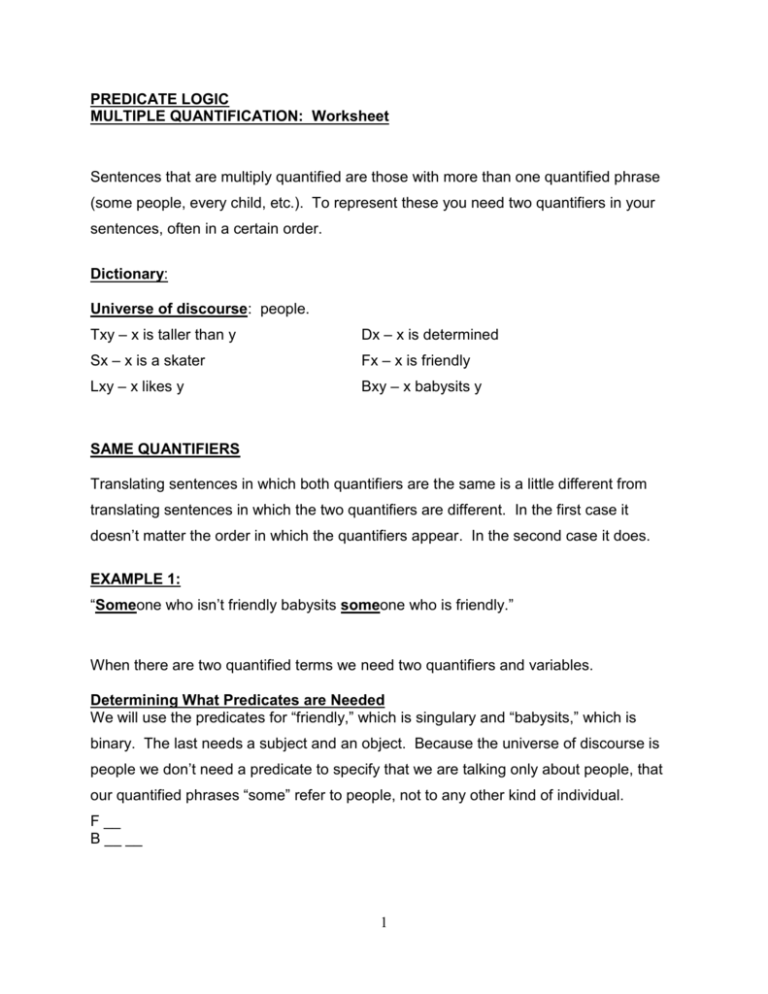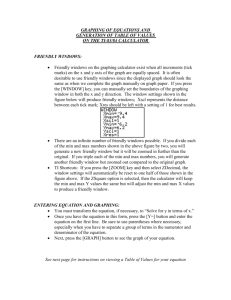Represent the following formula
advertisement

PREDICATE LOGIC MULTIPLE QUANTIFICATION: Worksheet Sentences that are multiply quantified are those with more than one quantified phrase (some people, every child, etc.). To represent these you need two quantifiers in your sentences, often in a certain order. Dictionary: Universe of discourse: people. Txy – x is taller than y Dx – x is determined Sx – x is a skater Fx – x is friendly Lxy – x likes y Bxy – x babysits y SAME QUANTIFIERS Translating sentences in which both quantifiers are the same is a little different from translating sentences in which the two quantifiers are different. In the first case it doesn’t matter the order in which the quantifiers appear. In the second case it does. EXAMPLE 1: “Someone who isn’t friendly babysits someone who is friendly.” When there are two quantified terms we need two quantifiers and variables. Determining What Predicates are Needed We will use the predicates for “friendly,” which is singulary and “babysits,” which is binary. The last needs a subject and an object. Because the universe of discourse is people we don’t need a predicate to specify that we are talking only about people, that our quantified phrases “some” refer to people, not to any other kind of individual. F __ B __ __ 1 Determining the General Structure: Compound and Atomic The sentence picks out an individual (a person) who isn’t friendly (and one who is) and says that the first babysits the one who is friendly. We can assert the existence of the first, saying they are not friendly, then assert the existence of the second, saying they are friendly, then say that the first babysits the first. Or we can assert the existence of both and then say that one baby sits the other. ~F__ & (F__ & B __ __) or (~F__ & F__) & B __ __ Translating the First Quantified Phrase “Some” The sentence says something about at least one friendly individual. We need a variable to help us represent that individual and a quantifier to say that we are asserting that there is at least one. Hence we should preface the formula with “(Шx).” To say that, in our sentence, the “x” refers to a person who is friendly, we need to put an “x” to the right of the first predicate “F.” (Шx)[~Fx & (F__ & B __ __) Translating the Second Quantified Phrase “Some” We also need a quantifier and variable to represent the individual is friendly and gets babysat by the first. Since the second individual is different from the first individual and appears in the same atomic formula we need a new variable “y.” To assert the existence of this individual we need (Шy). We could put this quantifier at the front of the formula, after the (Шx) since the sentence is written in the active voice such that it asserts the existence of an individual “x” who babysits the other. We could also put it just before the phrase that says something about the second individual (that they are friendly). Finally, since x babysits y we need to place the “x” and “y” in the subject and object position respectively to the right of the predicate letter for babysitting. (Шx)(Шy)[~Fx & (Fy & Bxy) or 2 (Шx)[~Fx & (Шy)(Fy & Bxy) DIFFERENT QUANTIFIERS EXAMPLE 2: “Everyone who is friendly and is taller than Sam babysits someone.” When there are two quantified terms we need two quantifiers and variables. Because the quantifiers are not the same we need to place the first one first and the second, second. Determining What Predicates are Needed We will use the predicates for “friendly,” which is intransitive, “taller than,” which is binary, and “babysits,” which is binary. The last two need a subject and object position. Since we have a proper name to designate who the people are taller than, Sam, we will put “s” in the object position of the predicate “T.” Because the universe of discourse is people we don’t need a predicate to specify that we are talking only about people, that our quantified phrases “every” and “some” refer to people, not to any other kind of individual. F __ T __ _s_ B __ __ Determining the General Structure: Compound and Atomic The sentence picks out the group of people who are both friendly and taller than Sam. To show that these people need to meet both criteria we need to connect the predicates “friendly” and “taller than Sam” with an “and.” Furthermore, after identifying them the sentence says that they babysit someone. So being a babysitter is a consequence of someone being someone meeting the condition of being friendly and taller than same. In other words, this sentence is a conditional (like an A statement). And the atomic sentence that talks about babysitting needs to come after the conditional symbol. We can read it as “If x is friendly and taller than Sam then s/he babysits someone.” (F__ & T __ _s_ ) 3 B __ __ Translating the Part with the First Quantified Phrase “every” The sentence says something about any person who are both friendly and taller than Sam. We need a variable to help us represent those people and a quantifier to say that we are talking about all people who meet both conditions. Hence we should preface the formula with “(x).” To say that the “x” only refers to friendly and tall people we need to put an “x” to the right of the predicate “F” and in the subject position (immediately to the right of the predicate taller than “T” and before the “s.” Finally, since we are saying that the people who meet those conditions babysit, we need to put an “x” in the subject position (x)[(Fx & Txs) Bx __] Translating the Part with the Quantified Phrase “some” After identifying the people the sentence is talking about (friendly who people taller than Sam) the sentence says these people babysit someone. We need an existential quantifier and a variable to represent “some.” Because “x” represents the people who do the babysitting and these people do not necessarily babysit themselves we cannot represent the people who are babysat with an “x.” We need a different variable to represent the people who are babysat. Hence we will use “y.” We could put the existential quantifier at the front of the formula, after the universal quantifier, or inside the formula right before the predicate for babysitting. (x)(Шy)[(Fx & Txs) Bxy] or (x)[(Fx & Txs) (Шy) Bxy] Using the dictionary provided, translate each of the following formulas into predicate logic. 1. Everyone likes someone. 2. Everyone likes Ann and Ann likes some people. 4 3. Someone likes everyone. 4. Everyone is liked by someone. 5. Ann likes anyone she babysits. 6. Everyone who babysits someone likes them. 7. Anyone who is determined babysits Carol. 8. Anyone who is determined is liked by someone. 9. People who are taller than Ann are friendly and determined. From Logic to English 1. (x)(Шy)(Lxy) 2. (x)(y)(Bxy) 3. (Шx)(y)(Bxy) 4. (x)(Шy)(Lyx) 5. (Шx)[Dx & (y)((Dy & Txy) Lxy)] 5









